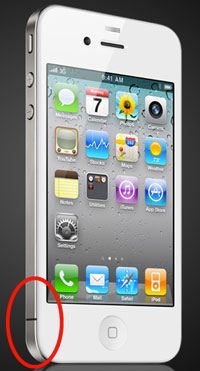There have been a lot of discussions over the past couple of days about an antenna issue with the new Apple iPhone 4. Mine isn’t here yet (grumble), so I have to rely on what others have been experiencing. But, apparently, if you hold the new iPhone in such a way that your hand bridges the gap between the two antennas on the left side (circled in red on the image), you can lose reception to the point that calls are dropped. Ouch.
Engadget supposedly got an answer from Apple yesterday that, yes indeed, holding the iPhone 4 with your hand covering the lower-left corner will degrade the signal.
So, we just spoke with Apple and got the straight dirt on the reception issues that have been plaguing users today… and it’s a little surprising. In essence, Apple cops to the fact there are reception issues with the new iPhone — namely, that if you cover the bottom-left corner of the phone and bridge the gap between the notch there with your naked flesh, you could see some signal degradation.
Not a great “design” solution or issue resolution to tell customers to “hold different”. But, our desire for ever-thinner, smaller, and more elegant smartphones has painted us into a bit of a corner in terms of a hardware design for the antenna that meets the FCC requirements to minimize radiation exposure. There is a very interesting article on the site of AntennaSys, an antenna solutions company, that explains the conundrum that Apple faced in trying to elegantly design the antenna into the iPhone 4. So, in the end, the placement of the antennas is what it is to place radiation exposure as “far” from your head as possible. Of course, we could always go back to the pullout antennas, to achieve that modern-retro design blend. 😉
So, that explains the antenna placement. But, I think we have to look to Apple for the industrial design decision to not use a material solution to prevent the skin conduction problem. To keep the clean look of the metal edge, they did make a conscious decision to not cover that area with a nonconductive material. Using a case does cover it and prevent the problem. But, using a case kind of defeats the purpose of showing off that elegant industrial design.
This simply highlights the age-old design challenge of form and function. Inevitably, unless you’re really lucky, designers come up against a decision where they need to balance form and function. Sometimes it is subtle (and the customers may never even notice the tradeoff), but sometimes it is quite blatant and customers are left wondering why either the function suffers or the design sucks. In the case of the iPhone 4, function suffered to allow form to shine (hence the dropped calls issue). This challenge faces all designers in all industries and you see passionate advocates on both sides, whether it is arguing about web design or even bicycles.
My favorite example of “getting it right” is Japanese woodworking tools. Many years ago, woodworking was one of my hobbies and over the years I learned where to find quality tools. I discovered the incredible balance of form and function when I bought some Japanese woodworking tools. Tremendous attention to detail in the quality of the folded layers of Damascus steel, amazing durability, an elegant design harmony between handle and blade, and a sheer pleasure to hold in your hands and use. Whenever I think of achieving a true balance of form and function, I think of these tools. So, could Apple have achieved this with the iPhone 4? I don’t know. But, it is a shame that a better balance wasn’t found to preserve such a critical component of phone function.

